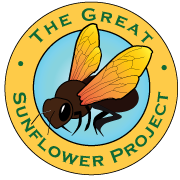Click one of these links to see our results using data collected up through 2012.
- State averages for pollinator service
- Effect of development
- Effect of garden size
- Effect of type of habitat around garden
- How does pollination change across the year?
These data are not completely verified If you would like to gain access to the verified data, please contact us at sfbee@sfsu.edu and read our data policy.
How does garden size influence pollinators (mean bees per hour)?
We are noticing that larger gardens have higher pollinator service (average bee visits in an hour) but that even small gardens do well. Community gardens do appear to have really good pollinator service which is important for food production. Sunflowers or other plants in pots have lower rates of visiting but still get some.
How does the habitat surrounding a garden affect pollinators (mean bees per hour)?Note: null or blank rows are ones where gardens haven't filled out the information on their garden.
Here we notice that the more shady sites (forest) versus less shady (forest edge) have lower rates of visitation. This isn't unexpected because bees avoid shade. Deserts are also well known for their diverse bee communities and that may help explain why gardens in these areas have such high visitation rates. We are not sure how to interpret the low rate of visits in gardens surround by shrublands.
How does the amount of development influence pollinators (mean bees per hour)?
The interesting trend here is the improved pollinator service as we decrease the density of housing. Urban areas have the least pollinator service, rural and wildland areas do best. One of the main factors thought to influence bees is loss of habitat and these data would suggest that may be true. Interestingly, when we looked at this early in the project with much less data, we did not see low pollinator service in urban centers. The more data we can bring to bear on a question, the more robust our results.
How does pollinator service change across a year?
This shows us how pollinator visits per hour change across a year. One thing to remember is that we've combined data from all over the US in this graph which means that the peak pollinator time in Florida is probably responsible for some of the high numbers for the early months whereas the peak pollinator time in the Northern states probably contributes more in July and August. The months are represented by numbers here.
